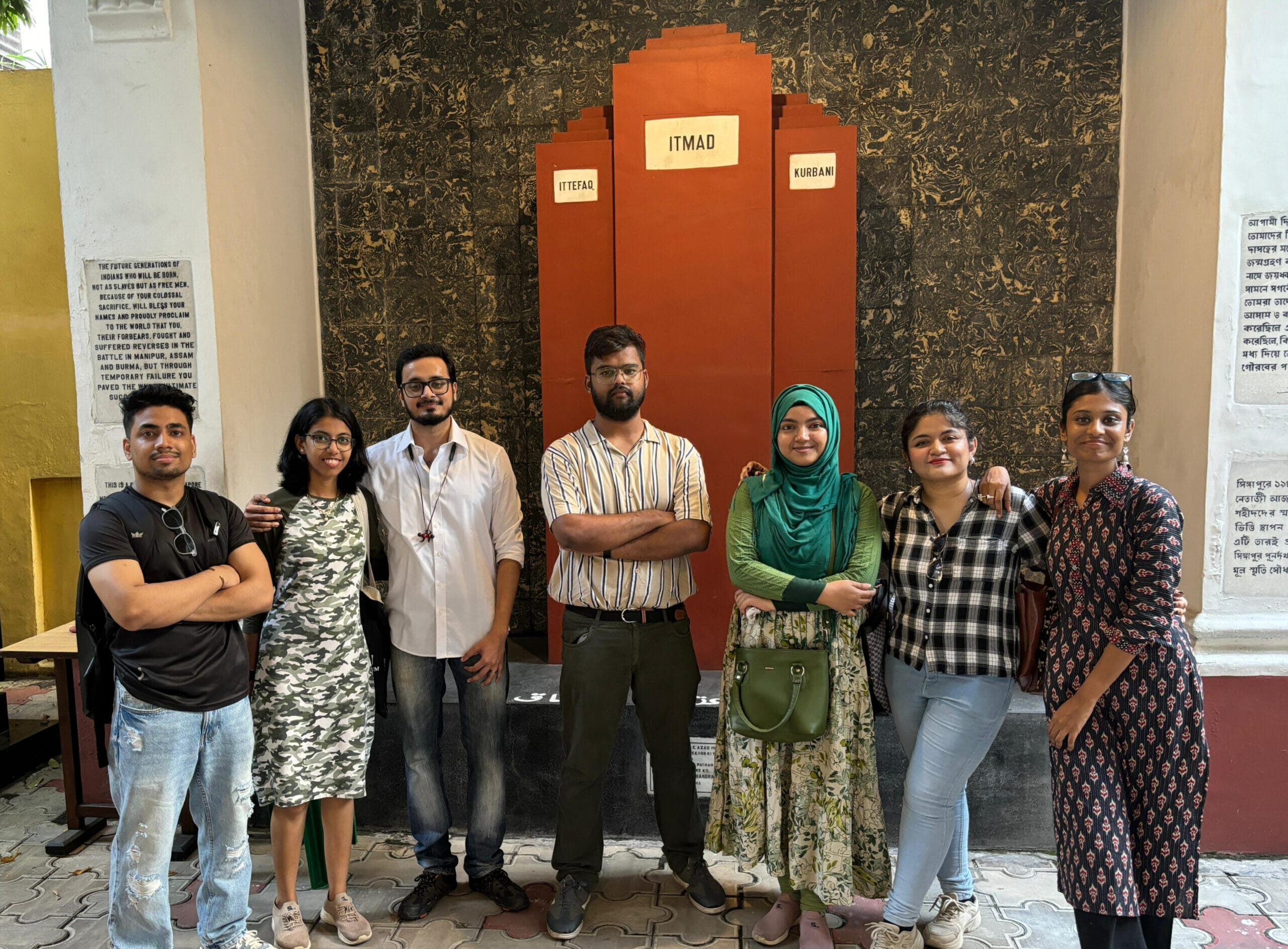Kolkata is a city that bears many stories from the yesteryears. It all began with the aggregation of villages, eventually giving birth to the city. It later became the capital of British India. So, at its heart, Kolkata has always been a storyteller. However, nothing captures the imagination of Calcuttans more than the tales of their historical and cultural icons, told through a dedicated Kolkata heritage walk.
We realized, however, that most people today dislike history because of the dry and uninspiring way it is presented. But it doesn’t have to be this way. We don’t need to experience history confined to reading monochromatic pages full of dense paragraphs and obtuse text.
Walking down lanes that once witnessed revolution, you can feel the weight of history. Courtyards, once home to royals, now lie abandoned and decaying, yet still echo with their grandeur. The rituals, unchanged for centuries, continue to captivate with their timeless beauty and reverence.
The city hides its stories in every nook and cranny. Through our Kolkata heritage walk, we try only to discover and tell them to those with ears to listen. So, on 22nd September 2024, we prepared to visit three iconic residences—Asutosh Mookerjee Memorial Institute, Netaji Bhawan, and Rani Rashmoni Bhawan.
So we began the first edition of our freshly minted initiative, Calcutta Crosswalks, a Kolkata heritage walk experience not only across the city but also across time, all through stories that enthral, surprise, and inspire.
Asutosh Mookerjee Memorial Institute
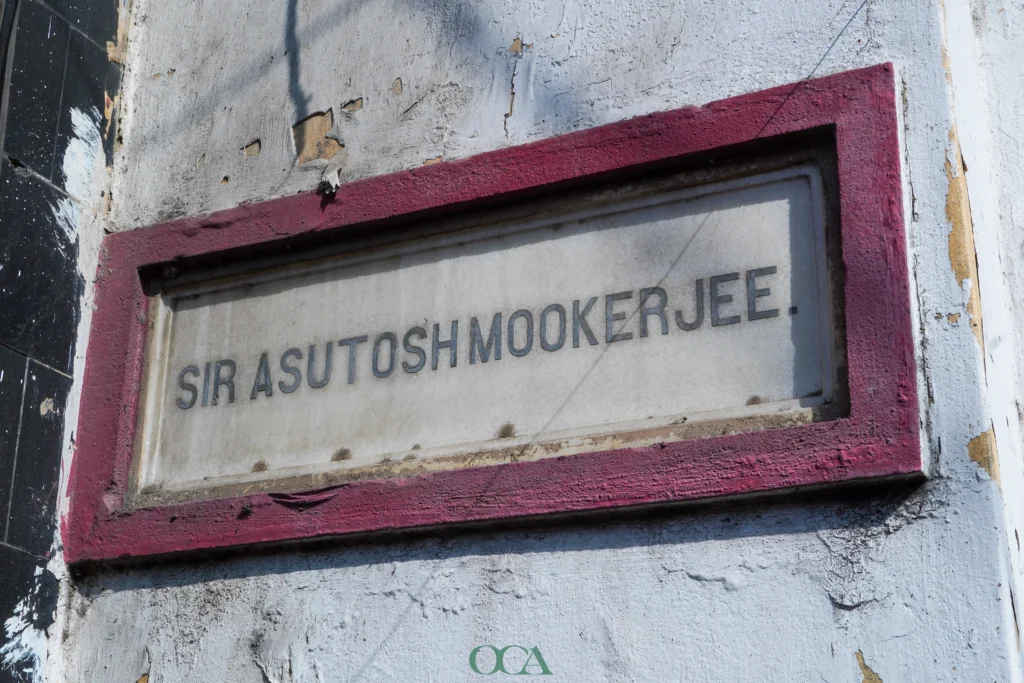
The first stop on our Kolkata heritage walk was the well-known but often overlooked Asutosh Mookerjee Memorial Institute. It is a rather inconspicuous three-storey building on 77, Ashutosh Mukherjee Road, Bhawanipore.
The mansion was built in the opulent Bengali style of the late 19th and early 20th centuries. It features an imposing facade with Corinthian pillars, cast-iron railings, and wooden louvres. Unfortunately, like many old buildings in the city, it is now largely obscured. Hawkers’ stalls clutter the pavement, hiding the mansion from view.
Taking one look at the building, however, is enough to impress even the most casual visitor. The neoclassical architecture with its symmetry, grandeur, and intricate carvings, makes a noticeable impact. The grand entrance, large enough to fit a full-grown elephant, leads through a long corridor to the interior. We climbed the stairs to a gallery containing photos of Sir Asutosh and his son Dr Shyamaprasad Mukherjee.
This house was not only the ancestral home of Sir Asutosh Mukherjee. It was also an establishment that has played a crucial role in shaping the socio-political history of Bengal. It hosted some of the biggest names in 20th-century Bengali history. Rashbehari Ghosh, Dwarakanath Mitra, Jadunath Mukhopadhyay, Mahendralal Sarkar, and Pandit Ishwarchandra Vidyasagar, have all graced its halls. But the former residence of the Mukherjee family has perhaps been made most prominent by the Tiger of Bengal himself—Sir Asutosh Mukherjee.
The Legacy of Sir Asutosh Mukherjee
A prominent Bengali educator, jurist, barrister and mathematician, Sir Asutosh was a phenomenon all unto himself. Being the first student to earn a dual degree from the University of Calcutta, he would transform the education system.
As the Vice Chancellor of the university and President of the inaugural Indian Science Congress, Sir Asutosh established several well-known institutions like Hazra Law College and Asutosh College. His sheer courage and integrity would eventually earn him the moniker “Banglar Bagh” (Tiger of Bengal). He served as the Chief Justice of the Calcutta High Court until the end of his life.
Netaji Bhawan
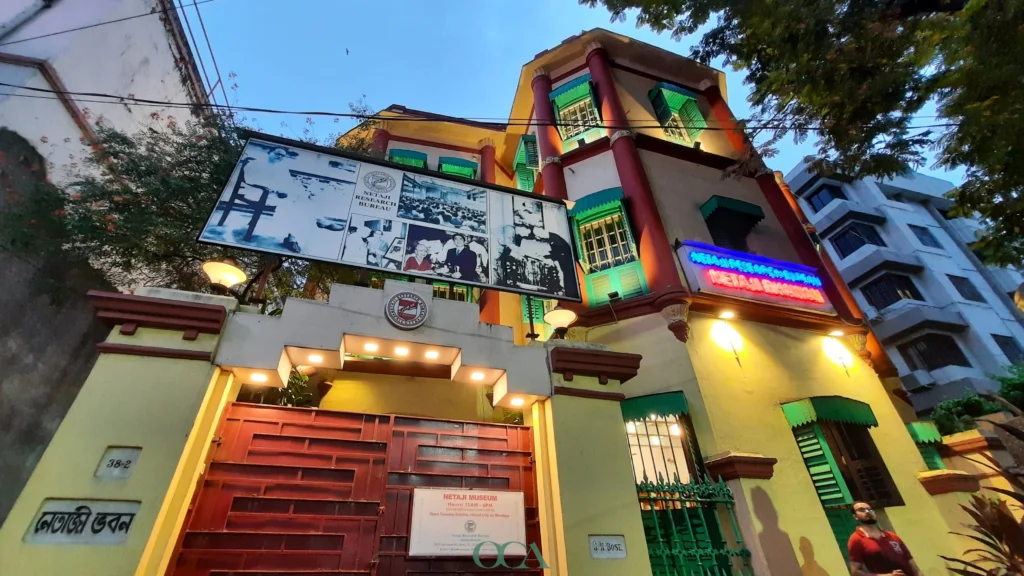
After a short walk, we arrived at the second stop on our Kolkata heritage walk, Netaji Bhawan. This house on 38/2, Elgin Road was originally built in 1909 by Janaki Nath Bose, a successful barrister and father of two of the most prominent personalities in 20th-century Bengal—Sarat Chandra Bose and Subhas Chandra Bose.
The house, although built in the neoclassical style, seems to be surprisingly at home among the modern apartments surrounding it. Despite its age, it is remarkably well-maintained, and for a price of ₹40/-, entry is surprisingly cheap.
Upon entering the front portico, the very first thing we noticed was a striking marble plaque on the left wall, bearing Netaji’s “Political Testament” in his own handwriting, from his time on hunger strike in prison in November 1940.
Beyond that, the open courtyard hosts the iconic Wanderer car bearing the BLA 7169 plate. This car carried Netaji beyond the confines of house arrest on 17 January 1941 and paved the way for his great European and East Asian adventures that would eventually become the stuff of legend.
Further inside, a large replica of the INA Martyrs’ Monument stands proud, inscribed with three words: Ittefaq (Unity), Itmad (Faith), and Kurbani (Sacrifice). These ideals once summed up the spirit of the Indian National Army. The replica stands today as a substitute for the original in Singapore, built in August 1945 and destroyed by the British just a month later.
Netaji’s Bedroom
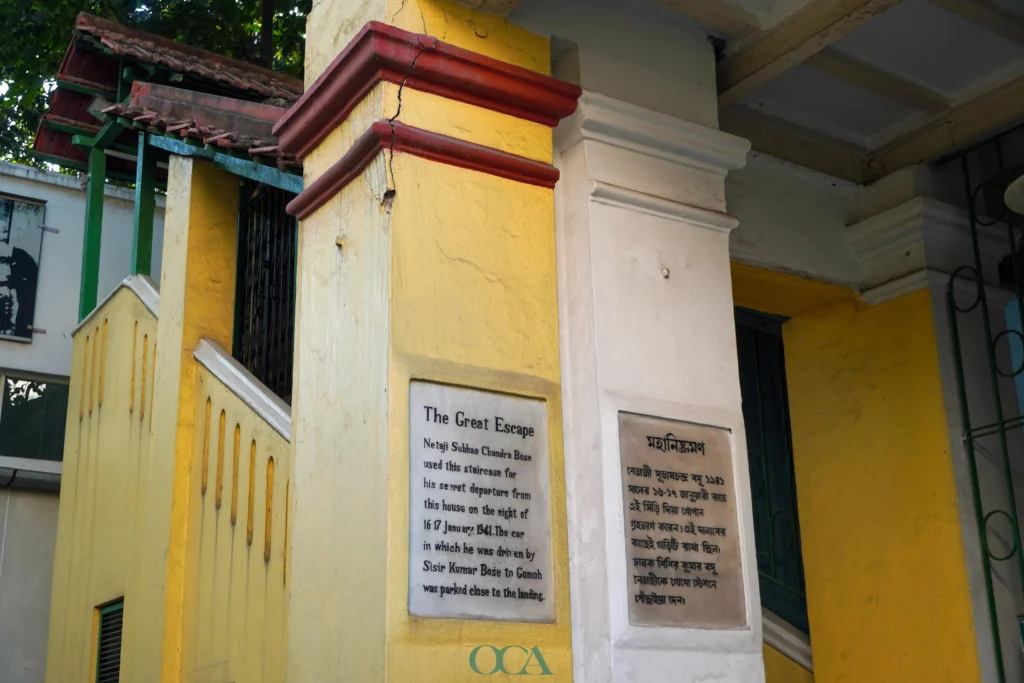
Upstairs, on the first floor, we walked through three rooms. The first of these was Netaji’s bedroom, where he was put under house arrest. Stepping into the room felt like witnessing a special place in the nation’s history. The most intriguing thing, however, was the trail of footprints along the verandah, leading to a staircase at the back, depicting the path Netaji took on the night of his Great Escape.
Entering the room, we saw the grand wooden bed where Netaji’s father Janaki Nath Bose once slept. Beside it was a smaller, almost unremarkable, iron cot where Netaji himself slept during his house arrest. A copy of the Bhagavad Gita, a pair of wooden slippers, a wash basin, and a few clothes, all have been preserved the way they were the night Netaji escaped.
The Sarat Chandra Bose Room
Moving into the Sarat Chandra Bose room, we saw the walls adorned with pictures of Netaji’s older brother. Sarat Chandra Bose’s role as Netaji’s biggest supporter has been forever immortalized. The room also contains a large bed and a desk, where Sarat Chandra Bose would work. However, it is the pictures that stand out, serving as a reminder of the entire Bose family’s contribution to India’s freedom struggle.
Netaji’s Office
The third room, with walls painted in the Indian tricolour, served as Netaji’s office. Here, he would receive important guests and dignitaries as President of the INC. The large wooden desk and office chair, the cushioned couches and coffee tables, and a cabinet full of gifts from guests tell us of the weight of the office that the man held.
The Central Gallery
Upstairs, on the second floor, we found three galleries—the Central Gallery, the Europe Room, and the Asia Room. The Central Gallery was the first stop, where Netaji’s days from his childhood to his eventual Great Escape are highlighted through pictures, clothes, and other artefacts.
We first see Netaji as a boy, then follow his journey through adolescence and young adulthood as a rising Swarajist. The room also showcases the clothes he wore and the utensils he used for his last meal before escaping. A journal entry by his father, recording his birth, is displayed, along with a letter he wrote to his mother, describing the glory and beauty of the nation. All of this together gave us a feeling of life coming full circle.
The Europe Room
The Europe Room, like the Central Gallery, had walls of photos and newspaper cut-outs telling stories of the nation’s most daring hero while he was on his European adventure. From writing and broadcasting under the Italian pseudonym Orlando Mazzota to travelling in a German U-boat after meeting Adolf Hitler, it is hard to sum up Netaji’s European journey in just a few paragraphs.
The Asia Room
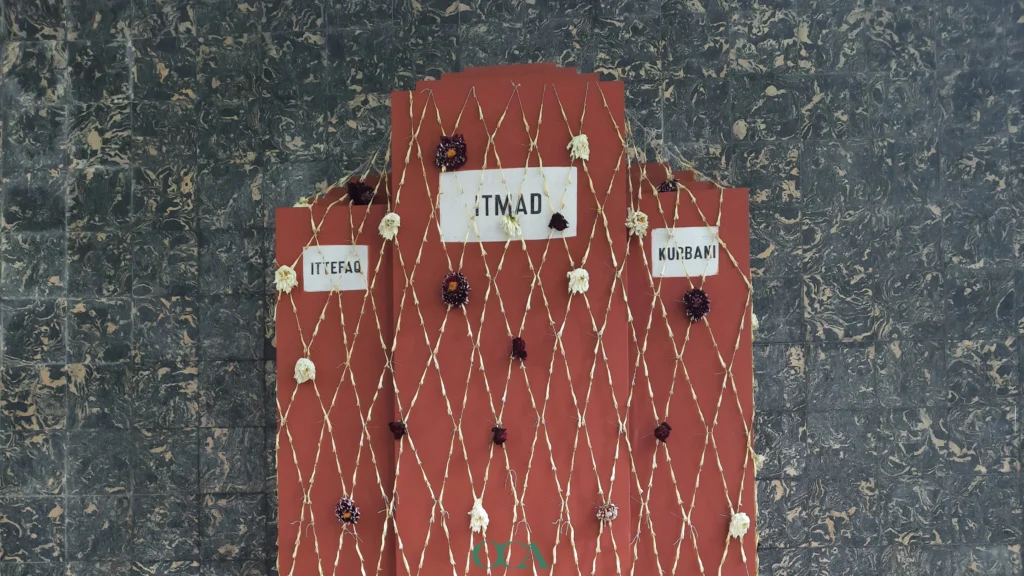
The Asia Room focused on Netaji’s time in Japan and Singapore, during which he founded the Azad Hind Fauj (Indian National Army). Interestingly, there is a katana (Japanese sword) encased in glass in the centre of the room, gifted to Netaji by the Emperor of Japan and later brought to India (after Netaji’s supposed demise) by General Fujiwara Iwaichi. A small piece of the original INA Martyrs’ Monument can also be found beside the katana.
Other noteworthy artefacts in this room include the garland that Netaji was gifted during his inauguration of the INA and the various insignia and sigils that the INA uniforms and cars bore.
After our grand tour of Netaji Bhawan was complete, we decided to move on to the third and final house on our list for the day—Rani Rashmoni Bhawan.
Rani Rashmoni Bhawan
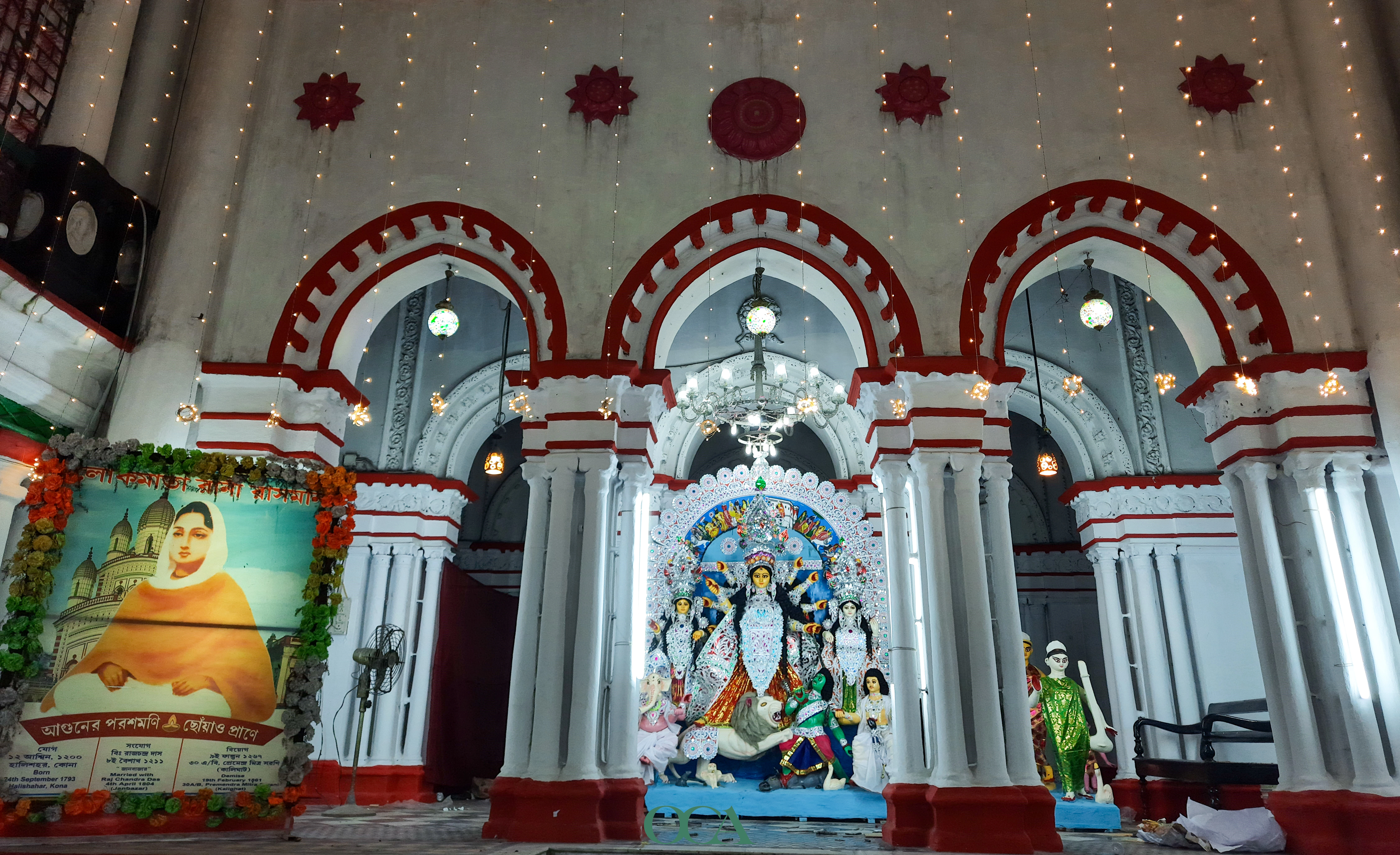
A short metro ride from Bhawanipore, we reached the third stop of our Kolkata heritage walk. Rani Rashmoni Bhawan in Janbazar stands amidst the chaos of the Esplanade area. The Bhawan is divided into three houses, all within walking distance. The most striking part, however, is its connection to Rani Rashmoni, who was not a natural-born descendant of the family but joined through marriage.
Biography of A Pre-Modern Feminist
Born in 1798 in the village of Halisahar in present-day Nadia, an eleven-year-old Rashmoni was married off to Babu Rajachandra Das, a wealthy (and significantly older) zamindar in the Janbazar area. The zamindar recognized her intelligence and business acumen early on and entrusted her with managing household affairs.
Tragedy struck in 1836, however, when the young Rani, now a mother of four daughters, lost her husband and had to shoulder all the responsibility of managing their vast estate. Supported by her son-in-law Mathur Babu, Rani Rashmoni got to work, reforming Bengali culture and the city as we know it.
Being a woman in a heavily patriarchal society, Rani Rashmoni had a steep challenge ahead, but she was not one to back down! She forced the British to abolish taxes imposed on fishermen and established several ghats along the Ganga for daily bathers. These include notable ghats like Babughat, Ahitritola Ghat, and Nimtola Ghat, further cementing her status as the fierce icon of 19th-century Bengali feminism.
She took a firm stance against child marriage and sati. She also donated significant sums to the Imperial Library (now the National Library) and Hindu College (now Presidency University). Her greatest contribution, however, was founding the Dakshineshwar Kali Temple in 1855. She accomplished this despite criticism for being a woman and from a lower Shudra caste. She eventually entrusted the temple’s administration to Ramkumar Chattopadhyay, a Brahmin, who later passed the responsibility to Ramakrishna Paramhansa.
The Walls That Speak of History
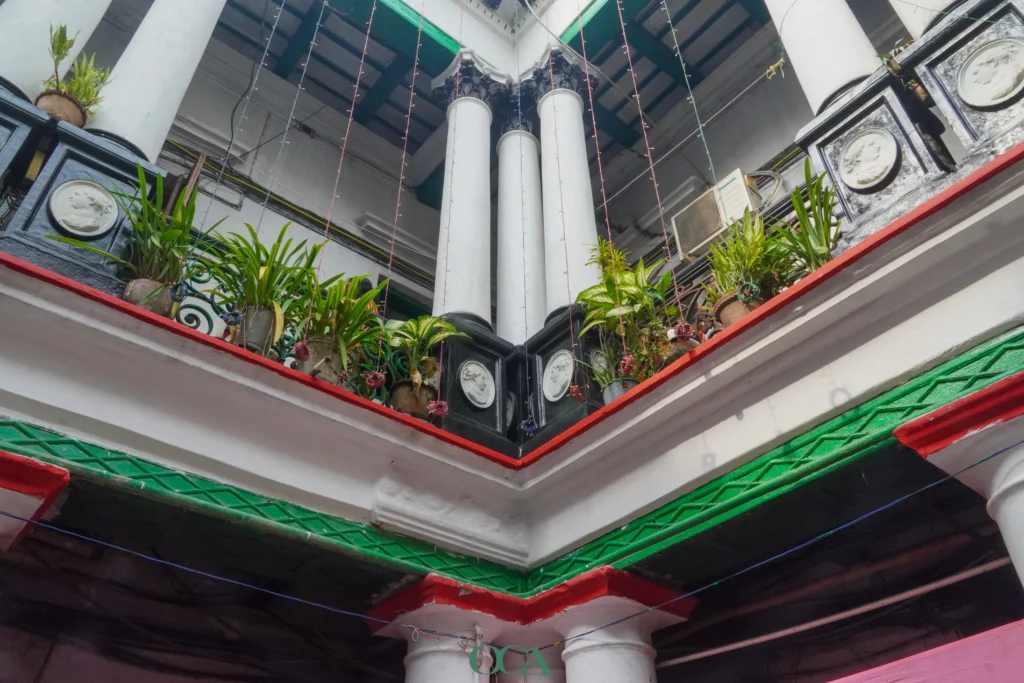
Entering Rani Rashmoni’s house was like stepping into a bygone era marked by glamour and opulence, but also unwavering integrity and philanthropy. The huge columns and stately arches invited us in. Artists painted the eyes on idols of the Goddess Durga and her children, unbothered by our presence.
A life-sized statue of the Rani sat cross-legged on a platform at one end of the thakurdalan, her eyes closed in bliss. Exquisitely designed chandeliers hung from the ceiling. We sat down in their soft golden light, taking in the aura of the place.
Most of the Rani’s descendants no longer live here, and squatters have mostly taken over the massive mansion. The glory that once was no longer is, but we can still see the vestiges of that wondrous beauty.
Leaving Rani Rashmoni’s house, we knew we had shared in the life of a powerful woman—a woman who, despite her birth, her sex, and her circumstances, challenged the powers of her time to cement her place in Kolkata’s history, much before the first cries of feminism rang out in the West.
A Walk Through Time
For the first edition of Calcutta Crosswalks, we wanted to present our small group of explorers with a different side of history. Walking through central Kolkata and standing among the remnants of these great houses offered a much more immersive experience than we can find in the pages of a history book. We focused on talking about these eminent personalities in a way that would tap into the primal human need for telling and listening to stories. But that was not our only aim.
Out on the city streets, there is always the possibility of discovering something new, raising new questions about what was, what is, and what can be. Traditional heritage walks, with their strict itinerary and emphasis on checklists, often miss that point.
We have a lot in store for you as part of Calcutta Crosswalks, our Kolkata heritage walk initiative. So if you’re interested in knowing more about our upcoming offerings, why not get in touch with us? With us, you not only immerse deeply in culture and life but also contribute to the local economy and sustainable travel.
The city is rich with stories, both told and untold, from the past. We have simply taken on the responsibility of bringing those stories to light.
